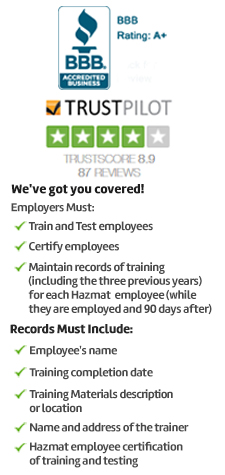
OSHA Oil and Gas Extraction Safety

Oil and gas exploration and extraction processes involve several hazards and risks which can lead to accidents and injuries to workers. This online safety course dwells into the safety aspects of oil and gas extraction by following OSHA formulated regulations and safety standards. The course teaches participants about the kind of dangers and risks workers face, applicable regulations, preventive measures, compliance procedures and how to manage risks and make workers follow all safety procedures and practices.
Governing regulations
OSHA has framed regulations 29 CFR 1910 for employers of General Industry which also applies to Oil and gas extraction industry which has specific state and federal regulations to follow for different forms of operations. For example, employers should follow the U.S. Department of Transportation (DoT) standards that apply to chemical transportation and highway vehicles.
Course Overview
Oil and gas exploration and extraction processes involve different forms of engineering equipments and machinery which can cause various levels of danger and risks for operating workers and others present close by. This course provides detailed description about machines and equipment that can be used and how to protect one from various kinds of dangers and hazards. The syllabus also includes various toxic substances and unhealthy work conditions which workers have to encounter while extracting oil and gas, implementation of safety measures, protective wears and safety gadgets, prevailing OSHA regulations to ensure occupational safety and health and effective risk management procedures.
Who Must Take this Course?
This course is specifically made for workers exploring oil and gas from deep wells in both offshore and onshore work environments. Those who are directly involved in operating heavy equipments and machinery and also those who provide supportive roles must have thorough knowledge on safety, hazards, regulations and importance of following safe work practices.
Course Format
Our online Oil and Gas Extraction Safety Training course offers specialized training to participants with high-quality content, graphical and audio clippings on concepts and also practice questions to help them secure high marks in the final exam.
All successful candidates will be provided with course completion certificates along with a printable wallet card.
Continuing education credits?
On completion of the safety course, candidates will receive 0.4 CEUs (or 4 CMEs) which they can mention in their professional profile.
Topics Covered
- About This Course
- Course Objectives
- Introduction to the Oil and Gas Extraction Safety Training Course
- Injury and Accident Statistics
- Applicable Regulations
- Preventative Measures to Protect Workers in the Oil and Gas Extraction Industry
- General Recommendations to Minimize Workplace Hazards
- Key Terms
- Introduction to Specific Hazards and Safe Practices to Protect Workers
- Vehicle Collision Hazards
- Applicable Regulations for Vehicle Collision Hazards
- Prevention Measures for Vehicle Collision Hazards
- Additional Prevention Measures for Vehicle Collision Hazards
- Challenges in Implementing Vehicle Safety Measures
- Additional Resources – Vehicle Collision Hazards
- Struck-By, Caught-In, Caught-Between, and Machine Hazards
- Applicable Regulations for Struck-By, Caught-In, Caught-Between, and Machine Hazards
- Prevention Measures for Struck-By, Caught-In, Caught-Between, and Machine Accidents
- Additional Resources – Struck-By, Caught-In, Caught-Between, and Machine Hazards
- Explosion and Fire Hazards
- Applicable Regulations for Explosion and Fire Hazards
- Prevention Measures for Explosion and Fire Hazards
- Additional Resources – Fire and Explosion Hazards
- Energy-Related Hazards
- Applicable Regulations for Energy-Related Hazards
- Preventative Measures for Energy-Related Hazards
- Lockout/Tagout Practices and Procedures
- Electrical Energy Hazards
- Prevention Measures for Electrical Energy Hazards
- Additional Resources – Energy-Related Hazards
- High-Pressure Lines and Compressed Gas and Air Equipment Hazards
- Applicable Regulations for High-Pressure Lines and Compressed Gas and Air Equipment
- Prevention Measures for High-Pressure Lines and Compressed Gas and Air Equipment Hazards
- Additional Resources – High-Pressure Lines and Compressed Gas and Air Equipment Hazards
- Confined Space Hazards
- Atmospheric Hazards
- Oxygen Deficiency
- Applicable Regulations for Confined Spaces
- Preventative Measures for Confined Space Hazards
- Additional Resources – Confined Space Hazards
- Slipping, Tripping, and Falling Hazards
- Applicable Regulations and Preventative Measures for Slipping, Tripping, and Falling Hazards
- Additional Measures to Prevent Slips, Trips, and Falls
- Additional Resources – Slipping, Tripping, and Falling Hazards
- Ergonomic Hazards
- Applicable Regulations and OSHA Recommendations to Address Ergonomic Hazards
- Prevention Measures for Ergonomic Hazards
- Additional Resources – Ergonomic Hazards
- Respiratory Hazards
- Applicable Regulations for Respiratory Protection in General
- Policies and Procedures to Provide Respiratory Protection
- Approaches to Reduce or Eliminate Respiratory Hazard Exposure
- Respiratory Protection for Oil and Gas Extraction Workers
- Respirator Classification
- Respirator Selection
- Silica Exposure
- Primary Sources of Silica Exposure
- Health Risks from Silica Exposure
- Applicable Regulations Specific to Silica Exposure
- Short-Term Approaches to Limit Silica Exposure
- Long-Term Approaches to Limit Silica Exposure
- Hydrogen Sulfide (H2S) Exposure
- Health Risks from Hydrogen Sulfide Exposure
- Applicable Regulations Specific to Hydrogen Sulfide Exposure
- Primary Sources of Hydrogen Sulfide and Exposure Control Measures
- Diesel Exhaust Exposure
- Diesel Exhaust Exposure Control Measures
- Additional Resources – Respiratory Hazards
- Chemical Exposure and Naturally Occurring Radioactive Material (NORM) Hazards
- Applicable Regulations for Chemical Exposure and NORM Hazards
- General Chemical Hazards
- Benzene Exposure Hazard
- Benzene Exposure Health Effects
- Benzene Exposure Health and Safety Control Measures
- Radioactive Material Exposure Hazard
- Prevention and Control Measures for Radioactive Material
- Additional Resources – Chemical and NORM Hazards
- Work Condition Hazards
- Applicable Regulations for Extreme Temperature Hazards
- Factors That Contribute to Heat Stress
- Health Concerns and Symptoms of Heat Stress
- Recommended Care for Workers with Heat Illness
- Prevention of Heat Stress and Illness
- Factors That Contribute to Cold Stress
- Health Concerns Related to Cold Stress
- Symptoms of Cold Stress Illness and Injury
- Recommended Care for Affected Workers
- Fatigue
- Addressing Fatigue in the Workplace
- High Noise Levels
- Applicable Regulations for Noise Exposure
- Additional Resources – Work Condition Hazards
- Summary
- Additional Resources
- Exam


 NEBOSH CERTIFICATE
NEBOSH CERTIFICATE NEBOSH DIPLOMA
NEBOSH DIPLOMA IOSH
IOSH SAFETY DIPLOMA
SAFETY DIPLOMA CPD UK
CPD UK ROSPA UK
ROSPA UK FOOD SAFETY
FOOD SAFETY 




